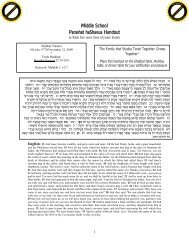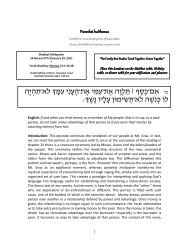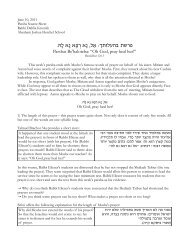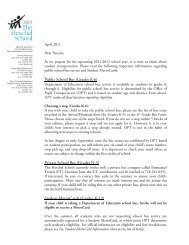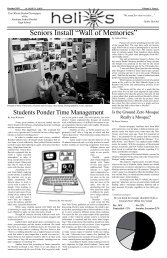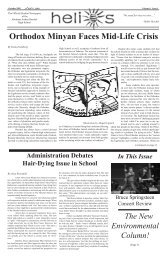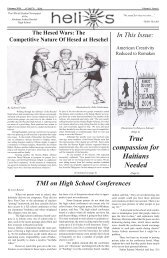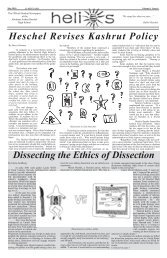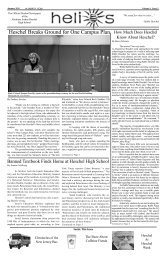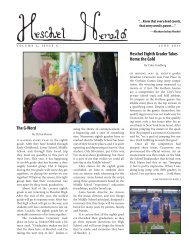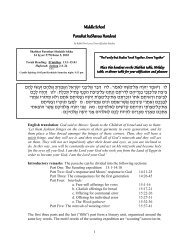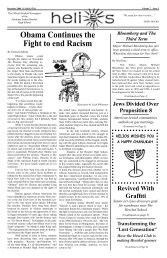SixTH AND SEvENTH GrADE SPECiAL EDiTioN - The Heschel ...
SixTH AND SEvENTH GrADE SPECiAL EDiTioN - The Heschel ...
SixTH AND SEvENTH GrADE SPECiAL EDiTioN - The Heschel ...
Create successful ePaper yourself
Turn your PDF publications into a flip-book with our unique Google optimized e-Paper software.
“…Know that every deed counts,<br />
that every word is power…”<br />
—Abraham Joshua <strong>Heschel</strong><br />
V o l u m e 2 , I s s u e 4 M a y 2 0 1 2<br />
<strong>SixTH</strong> <strong>AND</strong> SevENTH <strong>GrADE</strong> <strong>SPECiAL</strong> Edition<br />
EBooks, Light a Candle<br />
By Zoe Posner<br />
Today, ebooks and other academic<br />
technological devices are transforming<br />
the learning environments of schools<br />
all across the country. <strong>The</strong>se devices<br />
include the Kindle,<br />
Kindle Fire, iPad, Nook,<br />
Smartboards, the Internet and any other<br />
technology that feature digital books or<br />
educational games and exercises. Here,<br />
at <strong>The</strong> Abraham Joshua <strong>Heschel</strong> School,<br />
there are an increasing number of students<br />
making use of ebooks in classes.<br />
It is interesting to observe the subtle<br />
change ebooks are making in the learning<br />
environment.<br />
<strong>The</strong> question is, are ebooks superior<br />
or inferior to the classic, tangible book?<br />
With every technological<br />
leap forward,<br />
there is always controversy<br />
about the<br />
merit of each device<br />
and some who will<br />
say it is actually a<br />
step backward.<br />
Many educators<br />
dispute<br />
whether ebooks<br />
are beneficial to children’s overall learning<br />
experience. Some argue that the interactive<br />
activities that are included in<br />
Continued on page 7<br />
<strong>The</strong> Great Pizza<br />
Debate<br />
By Livia Miller, Leila Small<br />
and Kevin Chaikelson<br />
Not All Chairs Are<br />
Created Equal<br />
By Gidon Kaminer<br />
Sometimes, you can find luxury in<br />
the least expected places: maybe in a<br />
fancy car; maybe in a lavish meal; maybe<br />
in an expensive suit; and sometimes,<br />
even in a classroom chair. But some<br />
chairs are more comfortable, softer, and<br />
more luxurious, than the others. A careful<br />
survey of chairs found at the <strong>Heschel</strong><br />
Middle School revealed the diversity of<br />
chairs.<br />
Leila Small, Gidon Kaminer, and Kevin Chaikelson doing pizza math.<br />
Have you ever been walking<br />
down the street when<br />
you were suddenly struck<br />
by the delicious smell of<br />
fresh-baked pizza? Thinking<br />
of nothing but the warm<br />
aroma of NYC pizza, you<br />
wander into the nearest<br />
pizzeria. Suddenly you are<br />
jerked out of your reverie of<br />
hot, fresh pizza, as you stare at the prices<br />
on the menu. You storm out of the café,<br />
a scowl on your face. “Seriously! $15 for<br />
a small pie?” And of course, you might<br />
eventually decide that the price is so<br />
high because the pizzeria in question is<br />
kosher.<br />
Linda Messing’s math class decided<br />
to investigate. Many believed that kosher<br />
pizza was more expensive but wanted to<br />
mathematically uncover the truth. Students<br />
gathered their data and then compared<br />
the unit costs of one square inch<br />
of pizza from seven kosher pizzerias and<br />
from fifteen non-kosher pizzerias. Per<br />
square inch, the average cost of kosher<br />
vs. non-kosher wasn’t so high. However,<br />
the average cost for an entire non-kosher<br />
pizza is $13.56, while on the other hand,<br />
the kosher pizza’s average cost is $16.82!<br />
So the costs do not differ hugely, but and,<br />
as students had originally hypothesized,<br />
Continued on page 7<br />
One example of a superior chair is<br />
the long padded bench in Jude and Bev’s<br />
office. It is covered with black leather,<br />
and is very springy. Even though the<br />
padded bench is extremely comfortable,<br />
it is controversial, because some would<br />
not consider it a chair. Another type of<br />
chair in our school is the science room<br />
chair, a wooden stool that many students<br />
do not find comfortable. For starters, the<br />
science room chair has a very flat bottom<br />
and back, and is not curved, so your<br />
rear end sits on it awkwardly. Also, when<br />
Continued on page 7
2011–2012<br />
Editors<br />
Ariella Kahan<br />
Nico Miller<br />
Amelia Sylvor Greenberg<br />
Sports Editor<br />
Noah Knopf<br />
Contributing Writers<br />
Aaron Brandeis<br />
Eliana Salmon<br />
Ella Kaplun<br />
Gabe Scherzer<br />
Gidon Kaminer<br />
Grace Gilbert<br />
Hannah Zhukovsky<br />
Harris Zweig<br />
Joey Zemmol<br />
Laura Glesby<br />
Livia Miller<br />
Nathaniel Goldblum<br />
Noah Shapiro<br />
Rachel Ladds<br />
Sonia Epstein<br />
<strong>The</strong>o Canter<br />
Zoe Posner<br />
Letter from the<br />
Seventh Grade Editors<br />
Dear Students and Faculty Members,<br />
As the recently appointed editors for<br />
next year’s <strong>Heschel</strong> Herald, we are proud<br />
to present to you the new installment of<br />
the <strong>Heschel</strong> Herald! This is not just any<br />
issue of the <strong>Heschel</strong> Herald; this is the<br />
first issue in the Middle School newspaper’s<br />
history to be published exclusively<br />
by the sixth and seventh graders, while<br />
the eighth grade was in Israel. <strong>The</strong> newspaper<br />
staff has worked incredibly hard to<br />
publish this issue, and we hope you will<br />
find this newspaper as interesting and<br />
entertaining as we do. Hopefully, this<br />
will be the first of many more terrific<br />
issues to come. As the new editors, we<br />
are grateful to Amelia, Ariela, and Nico<br />
whose high standards shaped the last<br />
three issues; it is our hope to continue<br />
that tradition.<br />
Of course, if you have any questions<br />
or comments about this issue, you are<br />
more than welcome to write to us, and<br />
you’re guaranteed to receive interesting<br />
and entertaining answers!<br />
Sincerely,<br />
Your seventh grade editors,<br />
Hannah Zhukovsky, Eliana Salmon,<br />
and Sonia Epstein<br />
Everyone is reading the<br />
<strong>Heschel</strong> Herald; Be in the<br />
know: don’t be left out!<br />
Artists<br />
Amelia Sylvor Greenberg<br />
Livia Miller<br />
<strong>The</strong>o Canter<br />
Photographers<br />
Izik Mishan<br />
Karen Dorr<br />
Rick Munn<br />
Faculty Advisor<br />
Karen Dorr<br />
Layout & Design<br />
Abe Hendin<br />
Is Anyone EVER Gonna Write a<br />
Letter to the Editors???<br />
2 ◆ <strong>Heschel</strong> Herald, Volume 2, Issue 4 <strong>The</strong> Abraham Joshua <strong>Heschel</strong> School
Artful Desserts<br />
<strong>The</strong> 6th Grade exhibited their Artful Desserts to<br />
parents and students, April 21, 2012.<br />
Indie Rock<br />
By Livia Miller<br />
Many probably know at least one top 40 hit. Adele is a household<br />
name, and Nicki Minaj blasts from every radio station. However, there is<br />
music out there besides top 40 that is often neglected. For those yearning<br />
for a breath of (metaphorical) fresh air in our pop-clogged music radar,<br />
there are many indie artists who, while<br />
generally not followed by more mainstream<br />
listeners, have genuinely good<br />
music. Just two of many are Audrianna<br />
Cole and <strong>The</strong> Early November.<br />
Audrianna Cole<br />
Audrianna Cole began making music<br />
when she was staying at home with<br />
her critically injured father, who was<br />
discharged from the US Army after a<br />
car accident. Now, at eighteen years old,<br />
Ms. Cole’s voice is bubbly and sweet, and<br />
many of her tracks feature layered vocal<br />
tracks and guitar. Her music is cheerful<br />
and uplifting, but while still maintaining<br />
a heartfelt, sincere tone.<br />
<strong>The</strong> Early November<br />
<strong>The</strong> Early November is an American<br />
indie-rock band formed in Hammonton,<br />
New Jersey, by Arthur Enders in 1999; he<br />
is joined by guitarist Jim Sacco, bassist<br />
Sergio Anello, and drummer Jeff Kummer.<br />
<strong>The</strong>ir lineup has fluctuated in the<br />
past 13 years, but their sound stays the<br />
same. <strong>The</strong> Early November has a strong,<br />
bold sound akin to Green Day in their<br />
song, “Holiday,” but they still sound<br />
unique. ◆<br />
Happy Lag B’Omer!<br />
<strong>The</strong> Joseph Slifka Middle School May 2012 ◆ 3
Extremely Loud And<br />
Incredibly Close To <strong>Heschel</strong>:<br />
<strong>The</strong> Audition<br />
By Noah Shapiro<br />
Prior to the final casting of the new<br />
movie, Extremely Loud and Incredibly<br />
Close, two <strong>Heschel</strong> students auditioned<br />
for the role of “Oscar,” the young New<br />
York son of Sandra Bullock and Tom<br />
Hanks. <strong>The</strong> two students who auditioned<br />
are <strong>The</strong>o Canter in the sixth grade and<br />
Noah Lang in the seventh grade.<br />
<strong>The</strong>y were asked what the experience<br />
was like to audition for a movie<br />
with two famous actors. <strong>The</strong>o responded,<br />
“At the time of my audition I had no<br />
idea that two superstars would be in<br />
it. I didn’t even think that it would be<br />
that big a movie until eight months later,<br />
when I saw a huge film crew shooting<br />
the movie on my block. My experience at<br />
the audition was dramatic. Before I read<br />
for the part, the casting director asked<br />
me a few questions, “Do you know what<br />
a mausoleum is?” <strong>The</strong>n she asked, “What<br />
do you think the character Oscar means<br />
when he says “fukazowa you!” Finally, it<br />
was time for me to read for the part. As<br />
I said my words I had to smash a box<br />
and cry. <strong>The</strong> casting director’s assistant,<br />
who read the part of Oscar’s mom (later<br />
<strong>The</strong>o Canter<br />
Noah Lang<br />
to be played by Sandra Bullock) during<br />
my scene, made it difficult for me. She<br />
displayed little emotion, and did barely<br />
anything to play off of.”<br />
After learning from <strong>The</strong>o what his<br />
audition experience was like, Noah Lang<br />
was asked how the experience of auditioning<br />
impacted him. Noah said “<strong>The</strong><br />
auditions were definitely a good experience,<br />
I got to meet a lot of famous people<br />
and it gave me more confidence in my<br />
acting skills.”<br />
Finally, they reported what they<br />
thought about the movie after seeing a<br />
another actor play the part they auditioned<br />
for. <strong>The</strong>o commented, “Overall,<br />
I was extremely proud that I came so incredibly<br />
close to getting the starring role<br />
in this movie. Unfortunately, I was very<br />
disappointed upon seeing the movie.”<br />
Noah added, “I personally thought<br />
the movie was very good but I thought I<br />
could have been a better Oscar, just kidding.<br />
I was extremely disappointed when<br />
I found out I didn’t get the role. However<br />
I’m still keeping in touch with the casting<br />
director to see if I can get any new<br />
acting roles, so there’s still hope for my<br />
career.”<br />
For any of you <strong>Heschel</strong> students<br />
who have not yet seen the film, visualize<br />
<strong>The</strong>o and Noah in the role of Oscar and<br />
enjoy. ◆<br />
Book Review<br />
<strong>The</strong> Hunger Games<br />
By Sonia Epstein<br />
Many years ago, there was a place<br />
known as North America. Horrifying<br />
wars and disasters destroyed the land<br />
and the civilizations that had settled<br />
there. From the ashes emerged Panem:<br />
a stunning Capitol encircled by thirteen<br />
districts. But the catastrophes had not<br />
ceased. <strong>The</strong> thirteen districts rebelled<br />
against the Capitol. <strong>The</strong> Capitol responded<br />
ruthlessly, vanquishing twelve<br />
of the districts, and completely annihilating<br />
the thirteenth. <strong>The</strong> Treaty of<br />
Treason was created, giving new laws to<br />
ensure peace, and to guarantee the uprising<br />
against the Capitol would never<br />
be repeated, <strong>The</strong> Hunger Games were<br />
created. <strong>The</strong> Hunger Games is a form<br />
of entertainment for Panem, and a way<br />
for the Capitol to demonstrate its control<br />
over the districts. A boy and a girl<br />
between the ages of twelve and eighteen<br />
are selected randomly from each district,<br />
and are placed in a televised arena to<br />
fight to the death.<br />
Here is where Susan Collins’s novel<br />
begins. Sixteen-year-old Katniss Everdeen<br />
is a young woman living in District<br />
Twelve, one of the most impoverished<br />
districts. It is the day of the reaping, the<br />
day when a boy and girl will be selected<br />
to compete in the games. To Katniss’s<br />
horror, it is her beloved twelve-year-old<br />
sister, Prim, who is chosen. Katniss, who<br />
cannot bear to watch her sister take part<br />
in this brutal game, volunteers to replace<br />
her. What ensues is a rapidly-paced,<br />
drama-filled Hunger Games, concluding<br />
with a choice made by Katniss that<br />
may alter the future. This novel is truly<br />
captivating, and filled with the conflicts<br />
of having to compete in a brutal game<br />
where friendships cannot last.<br />
“I don’t know where to start,” says<br />
one seventh grader. She continues, “It<br />
is action packed. Awesome. It’s a little<br />
gruesome but if you can get passed those<br />
parts it’s a great book.” Another seventh<br />
grader adds,“[It’s] a fun entertaining<br />
week-end read.”<br />
A New York Times bestseller, <strong>The</strong><br />
Hunger Games is a must-read. <strong>The</strong> adventure<br />
continues in the next two books<br />
of this captivating trilogy: Catching Fire<br />
and Mockingjay. ◆<br />
4 ◆ <strong>Heschel</strong> Herald, Volume 2, Issue 4 <strong>The</strong> Abraham Joshua <strong>Heschel</strong> School
Philadelphia Trip<br />
Al Capone Slept Here!<br />
By <strong>The</strong>o Canter<br />
Recently, the sixth grade visited<br />
Philadelphia, Pennsylvania. On the trip,<br />
the sixth grade visited many of Philadelphia’s<br />
famous attractions, including the<br />
Herr’s Potato Chip Factory, the Amish,<br />
and the Franklin Institute. Another ‘attraction’<br />
that the sixth grade visited was<br />
the Eastern State Penitentiary.<br />
<strong>The</strong> Eastern State Penitentiary is a<br />
prison that was in use from 1821 until<br />
1971. When the facility first opened in<br />
1821, it was surrounded by a cherry orchard<br />
and farmland for miles, as far as<br />
the eye could see. <strong>The</strong> facility was erected<br />
to house 250 to 300 prisoners. Before <strong>The</strong><br />
Eastern Penitentiary was built, prisons<br />
were mainly built on the core value of<br />
physical torture, punishment, and isolation<br />
from society.<br />
However, with the penitentiary’s<br />
construction, a new value factor was<br />
added to the philosophy of prisons: repentance.<br />
<strong>The</strong> penitentiary was not designed<br />
to brand criminals so that they<br />
would be shunned, but rather to have the<br />
prisoners atone for their sins and to be<br />
rehabilitated so that they could re-enter<br />
society. ◆<br />
Washington Trip<br />
Jockey Hollow Camp Hike<br />
By Noah Shapiro<br />
After only an hour of travel by bus,<br />
seventh grade students arrived at their<br />
first stop in Jockey Hollow, in Morristown,<br />
NJ. Many were relieved to be able<br />
to stretch their legs, but there were a few<br />
who were a bit sad to leave the comfort<br />
of the bus. Students were split up into<br />
two groups, Tal B and Matar B and then<br />
Tal A and Matar A. <strong>The</strong> B-groups went<br />
to hike first while the A-groups went<br />
to see a log cabin where George Washington<br />
had stayed while his men were<br />
camped out nearby during the Revolutionary<br />
War. It was remarkable to think<br />
that George Washington fought against<br />
the British troops where students stood.<br />
<strong>The</strong> hike was only around a mile<br />
and the trail wasn’t very challenging<br />
except for the fact that many students<br />
were concerned about deer ticks. As students<br />
approached the area where George<br />
Washington’s men camped out, everyone<br />
looked in awe at the beautiful hillside<br />
view. <strong>The</strong> huts were simple tents and<br />
clearly afforded the soldiers a strategic<br />
advantage—they would be able to see approaching<br />
British troops. After students<br />
examined and entered the huts, they all<br />
raced down the hill at top speed, which<br />
felt great. ◆<br />
Washington Trip<br />
A River View: Washington, DC<br />
By Ella Kaplun<br />
Smelling the fresh river water,<br />
hearing the motor running, and seeing<br />
hair flying was part of the experience of<br />
being on the Potomac River Cruise. <strong>The</strong><br />
view from the river was a great way to<br />
experience Washington, DC.<br />
<strong>The</strong> entire seventh grade embarked<br />
onto the small boat with excitement.<br />
<strong>The</strong>re was a part of the boat with a roof<br />
and another part with a deck. <strong>The</strong>re were<br />
chairs and tables where we could eat<br />
chocolate cake brought along by Nina.<br />
Sitting on the chairs, we saw against the<br />
black sky the bright white lights of the<br />
White House, <strong>The</strong> Lincoln Memorial,<br />
the Washington Monument, and even<br />
the gold-lit dome of a Mosque!<br />
A seventh-grade student said, “I<br />
thought it was a nice way to view historical<br />
monuments in Washington, DC and<br />
it was fun to be with our friends.” As we<br />
gazed outside and stuck our hands out<br />
of the sides of the boat, we saw overhead<br />
big planes flying just a couple of meters<br />
above us! It was thrilling to hear the<br />
loud motors of the plane and to see its<br />
red lights just above our heads! Noah S.<br />
said, “I personally really liked the river<br />
cruise because I thought it was very<br />
peaceful compared to the bustling day<br />
trying to get to Washington.” Laura G.<br />
added, “It was great to see the sites from<br />
the water rather than by bus, and a nice<br />
place to talk with my friends.” ◆<br />
Everyone is reading the<br />
<strong>Heschel</strong> Herald; Be in the<br />
know: don’t be left out!<br />
<strong>The</strong> Joseph Slifka Middle School May 2012 ◆ 5
Washington Trip<br />
<strong>The</strong> Spy Museum, Bugged<br />
By Sonia Epstein<br />
<strong>The</strong> bus, crowded with teacher<br />
chaperones and seventh graders clutching<br />
electronic gadgets of all sorts, pulled<br />
to a stop outside of the International Spy<br />
Museum in Washington, DC. This activity<br />
was sure to be like none of the other<br />
visits to museums the seventh grade had<br />
participated in that morning: this was a<br />
scavenger hunt.<br />
Upon exiting the bus, the students<br />
and teachers entered the museum, looking<br />
curiously about, as they were lead<br />
passed several exhibits on their way<br />
upstairs. Finally, they arrived in a spacious<br />
room, occupied by five tables, each<br />
assigned a name: Alpha, Bravo, Charlie,<br />
Delta, and Echo. <strong>The</strong> students hurried<br />
to find a seat, and once everyone had<br />
settled down, the tour guides began to<br />
explain how the scavenger hunt would<br />
operate. Each table would act as a team.<br />
A leader was chosen from each of these<br />
five teams, and handed a packet of questions<br />
to share with their team. An envelope<br />
was also presented to the leaders.<br />
Inside were bugs; pieces of paper to represent<br />
the devices spies place on people<br />
they believe to be performing suspicious<br />
activities. If a team were to successfully<br />
plant a bug undetected on another team,<br />
the team who hid the bug would receive<br />
ten points. Lastly, each team was given<br />
a short quiz, containing questions relating<br />
to espionage. Team Bravo scored the<br />
highest, giving them a slight advantage.<br />
Finally, the teams were brought to the<br />
doorway one by one, and told to begin.<br />
Excitement ensued among the<br />
teams. Rushing about the building trying<br />
to acquire the necessary data and<br />
bugging the other teams while avoiding<br />
potential buggers made the time fly by.<br />
<strong>The</strong> topics of the questions ranged from<br />
information on the earliest methods of<br />
espionage to famous spies to code words.<br />
Navigating the unfamiliar building put<br />
the teams at a disadvantage, and the<br />
guards were none too eager to be of any<br />
assistance. Nevertheless, by the time the<br />
teams gathered in the lobby, each had<br />
found the answers to several questions.<br />
<strong>The</strong> tour guides collected the question<br />
booklets and points were tallied. “Bravo”<br />
was triumphant, securing first place<br />
with over a hundred points.<br />
Coupons for the gift shop were<br />
awarded to all participants, and the<br />
next half hour was devoted to combing<br />
through the store and buying tee shirts,<br />
pens and other souvenirs. Many students<br />
thought visiting the International<br />
Spy Museum was an exciting experience,<br />
though expressed minor disappointments.<br />
“I thought the game was fun, but<br />
I was disappointed when we couldn’t<br />
look in the museum in more depth.” says<br />
Ella Kaplun. Another seventh grader<br />
agreed that it was a fun experience, but<br />
commented that “we didn’t really have<br />
enough time.” A final seventh grader<br />
noted that the “teams were too big.”<br />
Overall, the scavenger hunt was a component<br />
of the seventh grade Washington<br />
DC trip filled with excitement and the<br />
thrill of competition. ◆<br />
6 ◆ <strong>Heschel</strong> Herald, Volume 2, Issue 4 <strong>The</strong> Abraham Joshua <strong>Heschel</strong> School
ebooks, cont’d from page 1<br />
some ebooks help to engross children<br />
in their reading; this, they say, leads to a<br />
lasting passion and enjoyment for reading,<br />
positive future reading habits, and<br />
an improvement in a child’s development<br />
as a reader. On the other<br />
side, are educators who oppose<br />
the adaption of the<br />
ebook in the classroom.<br />
<strong>The</strong>se educators believe<br />
that the additional features that are<br />
offered on a number of these digital devices<br />
can prove to be distracting to children<br />
and might impede their ability to<br />
develop new literary skills as they read.<br />
In order to acquire further insight<br />
about ereaders, Stephanie Entin, the<br />
Lower School librarian, and Robin Skolnik,<br />
the Middle School librarian, were<br />
asked a series of questions, so that they<br />
could express their personal opinions on<br />
ebooks. One question asked is whether<br />
they believe that a major flaw in ebooks<br />
is that it does not address a child’s need<br />
for interaction with their parents. <strong>The</strong> librarians<br />
were also asked to explain their<br />
views on the ebook and whether they believe<br />
it is inferior or superior to a physical<br />
book. Interestingly, they hold two<br />
very different beliefs. Stephanie is an immense<br />
supporter of ebooks and the integration<br />
of technology into our education.<br />
She believes that ebooks are interactive<br />
and that a child can still be involved and<br />
focused when using an ebook. When explaining<br />
her perspective, Stephanie said,<br />
Robin Skolnik, Middle School Librarian<br />
“Appreciating literature can be done<br />
in so many ways. Ebooks are simply a<br />
new platform in which to enjoy literature.”<br />
Stephanie added, “This platform<br />
has not been utilized to<br />
its full potential” and<br />
believes that it will be interesting<br />
to observe how the<br />
ebook will develop in the future.<br />
Stephanie noted that physical<br />
books help stimulate multiple<br />
senses such a vision and touch. Robin<br />
is a strong supporter of physical books.<br />
She believes that there is, “Great value<br />
in the books themselves as objects.” She<br />
also stated that while she is a strong supporter<br />
of printed books, she understands<br />
that ebooks are strongly appealing to<br />
youth, and does not, “discount their potential.”<br />
Indeed, Robin acknowledged<br />
that the Middle School is beginning to<br />
integrate ebooks into its educational system,<br />
and recently purchased a number of<br />
ereaders for our library. While Robin is<br />
open to accepting e-books as part of student’s<br />
education, she still holds firm in<br />
her opinion that ebooks are in fact inferior<br />
to the original paper book. She also<br />
provided this intriguing analogy comparing<br />
traditional paper books to candles<br />
stating that, “In the past, candles<br />
were considered a crucial and irreplaceable<br />
part of our lives. However, after the<br />
invention of electrically powered lights<br />
became more accessible to the general<br />
public, the use of candles for providing<br />
light was abandoned.” Robin and others<br />
hope that printed books do not become<br />
the candles of the future.<br />
Overall, it appears that ereaders are<br />
here to stay. It is odd to think that our<br />
generation may be the last to grow up<br />
on traditional paper books. Perhaps we<br />
should save and put away our favorite<br />
books for the future, when we can show<br />
our grandchildren the “candle” of our<br />
past. In the meantime, let’s all just keep<br />
reading in whatever form is best for each<br />
of us. ◆<br />
Itamar Oron and Benji Ashley doing pizza math.<br />
Pizza, cont’d from page 1<br />
they found that they were mathematically<br />
correct to believe that kosher pizzas<br />
are more expensive.<br />
Students found that the best buy<br />
for local kosher pizza is Cafe Viva, on<br />
Broadway and 97th Street, where a 14-<br />
inch pizza sells for $9.25—or six cents<br />
per square inch. That is lower than some<br />
non-kosher pizza prices! Also in the<br />
running was Pizza Pete’s on Columbus<br />
Avenue, which sells an 18-inch pie for<br />
$16.75—or seven cents per square inch. ◆<br />
Chairs, cont’d from page 1<br />
spinning the chair, it creates an odd<br />
creaking noise, which may get the sitter<br />
ejected from class for creating a<br />
disturbance.<br />
One of the most comfortable chairs<br />
in the school is the standard teacher<br />
chair, which spins 360 degrees, goes up<br />
and down, and is shaped for a person’s<br />
back. But some people claim that the<br />
chair is over-padded. <strong>The</strong> standard chair<br />
in school, the blue student’s chair, has<br />
metal legs and a hard plastic seat. It’s<br />
back reclines at an angle, and is also<br />
made of plastic. Both the back and the<br />
seat are curved.<br />
In the end, despite the number of<br />
comfortable chairs in the school, the<br />
most comfortable, handy, popular<br />
place to sit in the school is still... the<br />
staircase. ◆<br />
<strong>The</strong> Joseph Slifka Middle School May 2012 ◆ 7
<strong>Heschel</strong> Celebrates Yom Ha’Atzmaut<br />
<strong>Heschel</strong> Remembers Yom Hazikaron<br />
8 ◆ <strong>Heschel</strong> Herald, Volume 2, Issue 4 <strong>The</strong> Abraham Joshua <strong>Heschel</strong> School
Welcome Back 8th Grade!!!!!<br />
We Missed You!!!<br />
A Report From Israel<br />
By Rabbi Jack Nahmod<br />
April 25, 2012—When I last wrote, we<br />
were preparing for Shabbat in the Negev,<br />
at Kibbutz Yahel. After a restful<br />
and spirited Shabbat, we woke up early<br />
Sunday morning to drive north to Masada.<br />
Although the hike up was steep<br />
and challenging,<br />
many students were<br />
able to finish it in<br />
less time than they<br />
thought it would<br />
take. Once on top,<br />
we were able to use<br />
a Torah scroll provided<br />
by the park<br />
service for a special<br />
Rosh Chodesh<br />
Tefillah. It was<br />
particularly meaningful<br />
to be able to<br />
worship freely in a<br />
place where once we<br />
could not.<br />
After a quick<br />
descent and a salty<br />
and muddy respite<br />
at the Dead Sea, we<br />
proceeded north<br />
to stay one night<br />
in Netanya, on the Mediterranean. On<br />
Monday morning we visited the Aaronsohn<br />
house in Zikhron Yaakov, one<br />
of the first places that modern Zionists<br />
chose to begin our rebuilding process as<br />
a nation. It is incredible to travel a relatively<br />
short amount of time by bus and<br />
go from arid desert to green hills and<br />
valleys with flowing water! We hiked<br />
in and around Mount Carmel, the site<br />
of one of the most dramatic prophetic<br />
moments in our history, when Eliyahu<br />
challenges 450 false prophets. We then<br />
planted trees (see below) before visiting<br />
Tiberias for an introduction to the<br />
Kineret (see below) and a chance to get<br />
some ice cream.<br />
We arrived in Alon Tavor on Monday<br />
night, where we still are today. Yesterday<br />
morning began with a visit for<br />
some to Sylvia’s gravesite (a picture of<br />
the cemetery is below) and, for others,<br />
to a peak above Rosh Pina to see a view<br />
of the Galil. We then went to Tzefat to<br />
explore our spiritual roots, differences<br />
between Sefardim and Ashkenazim, and<br />
our taste for falafel and shwarma. From<br />
there we went kayaking, where it seems<br />
the point was really to see how wet we<br />
could get our friends in the other kayaks<br />
(very wet, it turns out). This rounded<br />
out our exposure to Israel’s major waters,<br />
from the Gulf of Eilat to the Dead Sea, to<br />
the Mediterranean, to the Kineret, and<br />
finally the Jordan River.<br />
Last night, after returning to Alon<br />
Tavor for dinner, we joined the community<br />
of Hoshaya for their Yom HaZikaron<br />
ceremony. One of our Israeli madrichim<br />
was able to arrange for our class<br />
to meet with 8th graders of Hoshaya<br />
beforehand, and it seemed that many of<br />
them connected nicely, speaking a combination<br />
of Hebrew and English. <strong>The</strong>n,<br />
when the official program began, our<br />
school was officially welcomed by the<br />
entire community. <strong>The</strong> ceremony was<br />
meaningful and moving, memorializing<br />
all those residents or<br />
relatives of residents<br />
of Hoshaya who lost<br />
their lives while<br />
serving in the army<br />
and from other<br />
attacks.<br />
This morning<br />
we learned about<br />
another early pioneer<br />
in the Galil,<br />
Rachel the Poetess,<br />
before joining the<br />
Yom HaZikaron<br />
ceremony of Degania,<br />
which was the<br />
first kibbutz. We<br />
then took a hike in<br />
Karnei Hitim, a hill<br />
with historical significance<br />
not only<br />
for the Jewish people<br />
but also for Muslims<br />
and Christians. Now the group is<br />
resting in anticipation of tonight’s Yom<br />
HaAtzmaut celebration in Tiberias!<br />
Tomorrow we are headed for Jerusalem<br />
after we participate in the national<br />
custom of visiting an army base. We will<br />
join other schools for a picnic before<br />
marking our arrival in Jerusalem with<br />
an art activity at the Tayelet.<br />
All in all, the trip has been amazing,<br />
with a variety of activities and many different<br />
encounters with history and issues<br />
of identity. I look forward to being in<br />
touch again soon! ◆<br />
<strong>The</strong> Joseph Slifka Middle School May 2012 ◆ 9



